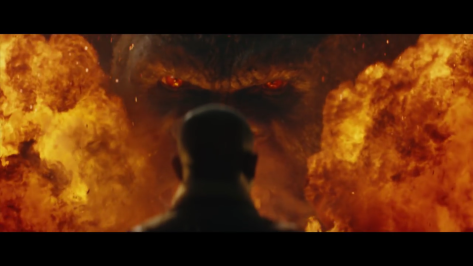Big Ape. Island. 1970s Vietnam backdrop. Movie. Synopsis over.
Kong: Skull Island is a Vietnam era period piece, something that acts as an important backdrop in the film. The stereotypes of U.S. in 1970s wartime dictate exposition and characterization.
The setup of Kong is messy in its expediency. A constant underscore of period relevant soundtrack keep conversations short and lacking in anything more than political platitudes.
Characters, as a result of this expediency and poor scripting, are trite and empty. Army grunts act like army grunts (although the comic relief involved in the realization of this trope is noticeably unsuccessful). The “anti-war photographer” (Brie Larson) is exactly this and nothing more. An ex-British forces turned hired hand (Tom Hiddleston) is essentially a Marvel superhero without the mask.
It is understood that depth of character is not what most will be looking for in a movie about a building-sized ape swinging his fists around for two hours. But when you are watching a two hour film, you are inevitably going to be subjected to dialogue. When that sad dialogue is put in the mouths of thin characters, then the majority of the film is frustratingly irksome.
The visual display of Kong: Skull Island is fairly good. Color palettes and large scale shots look gorgeous. More intimate action shots, however, are clunky and handled with sloppy editing. When the good and the bad are meshed together into action sequences, the product is more akin to Michael Bay’s Transformers than anything else.
The survival element of the narrative is the most interesting arm of the script, even if the characters are mere members of a shooting gallery plot. Once the ape paw hits the fan (read: chopper blade), there is room for an intriguing development. Shades of Cannibal Holocaust find its way into this plot and its shallow themes (the film is visually referenced, as well). This morality theme could have been leaned on more, perhaps, as this may have solved some character issues. Wishful thinking, I guess.
The film wants to take on King Kong’s original themes of irrational othering and villainization, hoping to be an allegory about Vietnam that can also translate to today. But this is a fool’s errand from John Goodman’s first line as he gets out of a taxi cab in Washington D.C.
The various issues in the film make way for a tonal confusion that is consistently evident. Scenes seemingly played for laughs fall flat. Scenes seemingly played in earnest that portray character deaths elicit laughs in the theater.
There is nothing particularly ominous about the island or its creature inhabitants save for what we are told to feel scared of by characters. In short, the film doesn’t sell the audience on its premise.
Kong: Skull Island is a heavily flawed film with plenty of flair to hide its blemishes. It just doesn’t hide them all that well. The film has a groovy soundtrack, above average concept art, half-decent acting, and cool landscape shots. What it lacks is developed characters, engaging dialogue, well-edited action sequences, and adequate pacing. You can call that a wash; I call it a disappointment.
Kong: Skull Island: D+
The Post-Script
Aren’t you all proud that I didn’t use the term apes**t anywhere in this review? It was right there for the taking, and I let it go. No ape feces puns, whatsoever. You did it, Alex. Be proud of yourself.
It really is apes**t, though. It’s a C- if I’m being generous. And I can’t be generous to a film with this much talent and anticipation behind it. Logan and John Wick: Chapter Two are still in theaters. Go watch them instead.
As always, thanks for reading!
Like CineFiles on Facebook for updates on new articles and reviews.
—Alex Brannan (@TheAlexBrannan)

